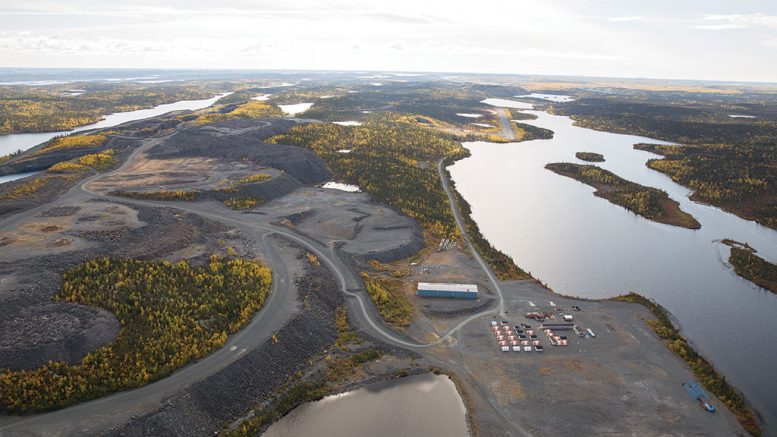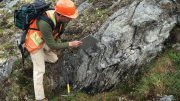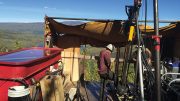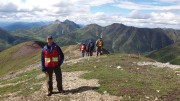Nighthawk Gold (TSXV: NHK) recently raised $25.1 million in equity to finance exploration at its Indin Lake gold project in the Northwest Territories, and Nighthawk president and CEO Michael Byron says the company’s 2017 exploration program will be its most ambitious yet.
In what will be its seventh drill program, Nighthawk plans to drill 25,000 metres this year at its flagship Colomac gold deposit, 200 km north of Yellowknife, as well at select priority targets across its 900 sq. km land package in the Indin Lake greenstone belt.
Colomac hosts an inferred resource of 2.1 million oz. gold (39.8 million tonnes at an average grade of 1.64 grams gold per tonne), and Kinross Gold (TSX: K; NYSE: KGC) thought highly enough of Nighthawk’s wholly owned project to take a 9.5% stake in the company in November 2016.
“It’s still early in the growth of Colomac, but we are confident in its multimillion-ounce expansion potential,” Byron says in an interview. “Now that we have the capital we can continue with our exploration agenda … in the early days, markets weren’t strong and we were challenged to raise the funds needed to do all the things we wanted to do. However, now that we have the resources, and the markets appear to be awakening to northern resource stories, I feel that we are in the right place at the right time, with the right asset.”
Between now and September, Nighthawk plans to drill Zones 1.0, 1.5, 2.5 and 3.5, and the Goldcrest sill; expand known high-grade zones along strike and to depth; and test other potential zones of higher-grade mineralization within the sills.
Within the Colomac sill, Zone 1.0 lies at its northern extent and Zone 3.5 about 6 km south.
(The zones were labelled sequentially based on their geographical distribution along the sill.)
Zone 1.5, Nighthawk’s newest high-grade discovery, is a zone that outcrops at surface, has boundaries along strike and is open at depth. Zone 2.5 and zone 3.0 are a couple kilometres south of Zone 1.5.

A drill rig at Nighthawk Gold’s Colomac gold deposit in the Northwest Territories. Credit: Nighthawk Gold.
The 2017 drill program will begin at Zone 1.5, where drilling last year returned intercepts of 52.1 metres grading 7.72 grams gold per tonne, including 25.5 metres of 14.25 grams gold in hole 16-03; and 72.7 metres of 5.58 grams gold, including 17.8 metres of 17.72 grams gold in hole 16-03B. The company plans to test the high-grade zone to depth along its 125-metre strike length.
Drilling will also target the resource gap between Zone 1.5 and high-grade Zone 2.0, immediately south, and test for a possible link between the two. If there is a link, it could result in a single high-grade domain that extends up to 300 metres in strike.
Testing the gap, Bryon says, is important because there has been no drilling in the area. “If these two high-grade zones are in fact one, or close enough to be considered as one, then their combined strike length may be upwards of 300 metres,” he says. “This has the potential to really change the nature of Colomac.”
Byron notes that Zone 1.5 lies just 100 metres north of the past-producing Colomac open pit. “The fact that it is essentially next to the former production pit, yet was never discovered, told me that opportunities were ripe in and around the deposit, and that [previous] exploration probably did not focus on areas lateral to the two main sills.”
Nighthawk’s exploration plans this year also involve drilling Goldcrest, a 2.5 km mineralized mafic sill 400 metres west of Colomac. The goal will be to test shallow high-grade mineralization to depth and target new opportunities within untested regions along strike to the north and south. Intercepts from Goldcrest have included 19.6 metres of 4.19 grams gold and 20.3 metres of 4.83 grams gold.
Other efforts in this year’s exploration season include prospecting and mapping programs focused on generating drill targets within the Nice Lake sill, which was discovered earlier this year, in February, about 1.5 km east of Colomac.
Nighthawk says Nice Lake, a mineralized quartz diorite intrusion, is similar to the Colomac and Goldcrest sills. It was discovered by prospecting geophysical targets outlined from airborne and ground magnetic surveys. About 40% of the grab samples collected along the Nice Lake trend contained gold, including a sample that returned up to 2.61 grams gold per tonne. The sill remains open along strike and has yet to be thoroughly mapped.
Byron notes that Nice Lake is 4 km long, with anomalous gold mineralization over much of its length. It lies parallel to the other sills Colomac and Goldcrest, and shares the same magnetic intensity and anomaly shape.
“This [mid-year] we will go back to do more work on that sill to see if we can generate drill targets,” he says, adding that in preparation for that work, Nighthawk has initiated an extensive ground geophysical program consisting of induced-polarization (IP) and magnetics.
“The crews are on-site, laying out the grids for the IP survey,” Bryon says. “Since high-grade Zone 1.5 showed itself as both a chargeability and resistivity high in a previous survey, we will now test other prospective areas along the sills to direct our drilling.”
Byron says Nighthawk could not execute these initiatives in the past due to the lack of funds. “Our current cash position allows us to shed those previous restrictions and focus our attentions on those areas deemed the most opportunistic,” he says, adding that the company expects to undertake a similar-sized exploration program in 2018.
Another discovery Nighthawk made last year, after sampling completed in 2012, was the Andy Lake prospect, 20 km south of Colomac. The company has identified a new style of gold-silver-bismuth mineralization that has not been reported previously in the Indin Lake greenstone belt. The company says gold with high silver and bismuth occur at both ends of Andy Lake in a granite host almost 1.3 km apart.
“Already Colomac is much more than what … was envisioned as a large-tonnage, open-pit operation,” Byron says. “It still has that potential and more. These high-grade domains give the potential that Colomac may be amenable to underground bulk-mining operations. This is how we see Colomac evolving over the next couple of years of drilling. Sure, this is forward-looking, but let’s just say it hasn’t been ruled out yet.”

Nighthawk Gold president and CEO Michael Byron
Nighthawk started poking around the Indin Lake greenstone belt in 2009 and began staking claims in 2010, culminating in its acquisition of Colomac in 2012. (Previously mined by Royal Oak Mines, Colomac produced just over 500,000 oz. gold from a shallow open pit.)
The company has tied up what Byron deems is the most prospective ground in the area, and the geologist calculates Nighthawk’s regional land package makes up more than 90% of the greenstone belt.
“What makes Nighthawk unique is that we have consolidated our regional land position,” he says. “There’s really not an abundance of regional plays like ours, especially in the North.”
The Indin Lake greenstone belt is the same age and has many of the same mineralization styles as the Timmins camp in Ontario. Unlike Timmins and Canada’s other established Archean gold camps, however, the Indin Lake area has seen little exploration, with the exception of brief periods in the 1950s, the late 1980s and the early 1990s. Byron sees that as a big opportunity.
Byron says Colomac has typical Archean gold mineralization. The host rock is a differentiated mafic intrusion, with gold preferentially located in the silica-rich upper part of the sill. The geologist says it shares many similarities to the Kalgoorlie gold camp of eastern Australia, including hosting large, high-grade domains.
In addition, Byron notes that the company does not have any earn-ins or option payments, so its carrying costs are annual mining lease payments and assessment work required to keep the ground in good standing, all of which amounts to $200,000 a year on average — “a totally manageable amount, given the size of our land position.”
Nighthawk’s shares are trading at 89¢ within a 52-week range of 12.5¢ (May 9, 2016) and 90¢ (April 13, 2017). The junior explorer has 187 million shares outstanding.






Be the first to comment on "Nighthawk cashed up, drilling 25,000 metres"